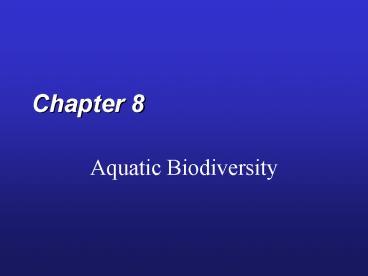Aquatic Biodiversity - PowerPoint PPT Presentation
1 / 19
Title:
Aquatic Biodiversity
Description:
Chapter 8 Aquatic Biodiversity * LITTORAL ZONE= Shallow area near shore, most sunlight--most productive area , biologically diverse--contains fish, insects, frogs ... – PowerPoint PPT presentation
Number of Views:210
Avg rating:3.0/5.0
Title: Aquatic Biodiversity
1
Chapter 8
- Aquatic Biodiversity
2
Natural Capital Major Life Zones and Vertical
Zones in an Ocean
3
Fig. 6-1a, p. 126
4
Core Case StudyWhy Should We Care About Coral
Reefs?
- Coral reefs form in clear, warm coastal waters of
the tropics and subtropics. - Formed by massive colonies of polyps.
Figure 8-1
5
Core Case StudyWhy Should We Care About Coral
Reefs?
- Help moderate atmospheric temperature by removing
CO2 from the atmosphere. - Act as natural barriers that help protect 14 of
the worlds coastlines from erosion by battering
waves and storms. - Provide habitats for a variety of marine
organisms.
6
Fig. 6-7b, p. 131
7
Estuaries and Coastal Wetlands Centers of
Productivity
- Estuaries provide ecological and economic
services. - Filter toxic pollutants, excess plant nutrients,
sediments, and other pollutants. - Reduce storm damage by absorbing waves and
storing excess water produced by storms and
tsunamis. - Provide food, habitats and nursery sites for many
aquatic species.
8
y
Herring gulls
Peregrine falcon
Snowy Egret
Cordgrass
Short-billed Dowitcher
Marsh Periwinkle
Phytoplankton
Smelt
Zooplankton and small crustaceans
Soft-shelled clam
Clamworm
Bacteria
All consumers and producers to decomposers
Producer to primary consumer
Secondary to higher-level consumer
Primary to secondary consumer
Fig. 8-7
9
Case StudyDams, Wetlands, Hurricanes, and New
Orleans
- Dams and levees have been built to control water
flows in New Orleans. - Reduction in natural flow has destroyed natural
wetlands. - Causes city to lie below sea-level (up to 3
meters). - Global sea levels have risen almost 0.3 meters
since 1900.
10
Mangrove Forests
Figure 6-8
11
What Kinds of Organisms Live in Aquatic Life
Zones?
- Aquatic systems contain floating, drifting,
swimming, bottom-dwelling, and decomposer
organisms. - Plankton important group of weakly swimming,
free-floating biota. - Phytoplankton (plant), Zooplankton (animal),
Ultraplankton (photosynthetic bacteria) - Necton fish, turtles, whales.
- Benthos bottom dwellers (barnacles, oysters).
- Decomposers breakdown organic compounds (mostly
bacteria).
12
Rocky and Sandy Shores Living with the Tides
- Organisms in intertidal zone develop specialized
niches to deal with daily changes in - Wave action
Figure 8-9
13
Human Activities Are Disrupting and Degrading
Marine Systems
- Major threats to marine systems
- Coastal development
- Overfishing
- Runoff of nonpoint source pollution
- Point source pollution
- Habitat destruction
- Introduction of invasive species
- Climate change from human activities
- Pollution of coastal wetlands and estuaries
14
Freshwater Life Zones
Fig. 8-15
15
Types of Lakes Oligotrophic
16
Types of Lakes Eutrophic
17
Effects of Plant Nutrients on LakesToo Much of
a Good Thing
- Plant nutrients from a lakes environment affect
the types and numbers of organisms it can support.
Figure 8-16
18
River Systems
- Runoff
- Drainage basin
- Watershed
- Floodplain
Rain and snow
Source area
Source Zone
Fig. 8-17
19
Rachel Carson
- All at last returns to the sea-to Oceanus, the
ocean river, like the ever-flowing stream of
time, the beginning and the end. - End chapter 8































